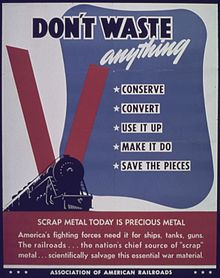 | |
| Abbreviation | AAR |
|---|---|
| Formation | 1934 |
| Type | Trade Association |
| Legal status | Active |
| Purpose | Advocate, public voice, educator, research, testing, safety & efficiency of railroads |
| Headquarters | 425 Third Street SW Suite 1000 |
| Location | |
| Region served | North America |
| Membership | Railroads and associates |
| Official language | English |
| President & Chief Executive Officer | Ian Jefferies |
| Subsidiaries | Railinc Corporation Transportation Technology Center, Inc. |
| Staff | 70 (DC office) |
| Website | www |

The Association of American Railroads (AAR) is an industry trade group representing primarily the major freight railroads of North America (Canada, Mexico and the United States). Amtrak and some regional commuter railroads are also members. Smaller freight railroads are typically represented by the American Short Line and Regional Railroad Association (ASLRRA), although some smaller railroads and railroad holding companies are also members of the AAR. The AAR also has two associate programs, and most associates are suppliers to the railroad industry.
Creation
AAR was created October 12, 1934, by the merger of five industry-related groups:
- The American Railway Association
- The Association of Railway Executives
- The Bureau of Railroad Economics
- The Railway Accounting Officers Association
- The Railway Treasury Officers Association
William George Besler was its first President.
Facilities and subsidiaries
The AAR is headquartered in Washington, D.C., not far from the Capitol. Its information technology subsidiary, Railinc, is based in Cary, North Carolina. Railinc IT systems and information services, including the Umler system, the Interline Settlement System and Embargoes system are an integral part of the North American rail infrastructure. Railinc delivers approximately nine million messages each day over its EDI network, including transportation waybills, advance train consists, blocking requests and responses and trip plans. Its applications support railroads, equipment owners and rail industry suppliers along every link of the supply chain. The company maintains the only industry-accepted version of the North American railroad industry's official code tables. Beginning as an information technology department within the Association of American Railroads (AAR), the company was established as a wholly owned, for-profit subsidiary of the AAR in 1999.
Another subsidiary, the Transportation Technology Center, Inc. (TTCI), operates and maintains the Transportation Technology Center, a 52-square-mile (130 km) facility 21 miles (34 km) northeast of Pueblo, Colorado, owned by the United States Department of Transportation. The facility is under a care, custody and control contract with the Federal Railroad Administration. TTCI has an array of specialized testing facilities and tracks. The site enables testing of freight and passenger rolling stock, vehicle and track components, and safety devices.
Functions
Where appropriate, the AAR represents its members' interests to the public at large and to Congress and government regulators in particular. The AAR works to improve the efficiency, safety and service of the railroad industry, such as through its responsibility for the industry's interchange rules and equipment specifications, e.g. for locomotive multiple unit control.
One of the AAR's duties is to oversee the assignment of reporting marks – two to four letter codes that uniquely identify the owner of any piece of railroad rolling stock or intermodal freight transport equipment (trailers, semi-trailers, containers, etc.) that can be carried on a railroad.
Reports
In November 2013 the AAR urged the U.S. Pipeline and Hazardous Materials Safety Administration (PHMSA) to press for improved tank car safety by requiring all tank cars used to transport flammable liquids to be retrofitted or phased out, and new cars be built to more stringent standards."
Members
AAR Full Members
- Alaska Railroad Corporation
- Railroads owned by Anacostia Rail Holdings Company
- BNSF Railway Company
- Canadian National Railway Company
- Canadian Pacific Kansas City
- CSX Transportation, Inc.
- Florida East Coast Railway
- Railroads owned by Genesee & Wyoming Inc.
- Indiana Rail Road Company
- Iowa Interstate Railroad, LLC
- Metra
- National Railroad Passenger Corporation (Amtrak)
- Norfolk Southern Corporation
- Railroads owned by R.J. Corman Railroad Group, LLC
- Union Pacific Railroad
- Vermont Rail System
- Railroads owned by Watco
- Wheeling & Lake Erie Railway
AAR Special Members (Canadian and Mexican Railroads)
- Canadian Pacific Kansas City (Mexican Operations)
- Ferrocarril del Istmo de Tehuantepec
- Ferrocarril y Terminal del Valle de México
- Grupo México Transportes
Former members
- Canadian Pacific Railway
- Ferrosur
- Kansas City Southern de México
- Kansas City Southern Railway
- Pan Am Railways
See also
- American Railway Association
- Organisation for the Combined Operations of Railways (OSShD)
- International Union of Railways (UIC)
- African Union of Railways (AUR)
- AAR wheel arrangement
References
- ^ Association of American Railroads (1988). Born out of necessity. Washington, D.C.: Association of American Railroads. p. 4. OCLC 80370940.
- "Association of American Railroads". Railway-News. Retrieved 2022-08-22.
- "Transportation Technology Center". Archived from the original on 1 May 2007. Retrieved 2007-04-19.
- "US Loco MU Control". Archived from the original on 2008-02-01. Retrieved 2008-02-13.
- "CN responds to CBC questions on DOT-111 tank cars". CBC News. 10 January 2014. Retrieved 18 February 2014.
- "AAR Members". Association of American Railroads. nd. Retrieved 16 August 2023.
Further reading
- Middleton, William D.; Smerk, George M.; Diehl, Roberta L., eds. (2007). Encyclopedia of North American Railroads. Indiana University Press. pp. 149–50.
External links
- Association of American Railroads website
- Railinc
- Transportation Technology Center
- Association of American Railroads (AAR) Reporting Marks
- AAR Records 1939~1978, PSU Library Archived 2021-01-11 at the Wayback Machine